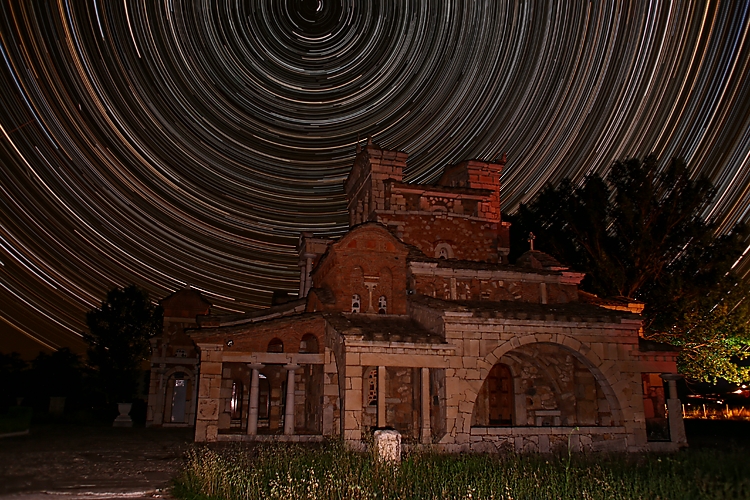
One of the most basic types of astrophotography and yet equally stunning is that involving star trails, particularly
around the celestial poles or immediately due east or west. In addition to capturing the motion of stars around the
north pole which are circumpolar and, hence, never rise or set, we also have the ability to capture seasonal
constellations and stars in such photos, thus allowing for different opportunities during different seasons. Star trail
photos also provide direct evidence that our planet rotates and does so at a rate of 15° per hour. Furthermore, by
studying the arc for a particular star, especially as far away from the pole as possible, one can indirectly estimate
the length of the (total) exposure which often ranges from seven to eight hours in duration and is totally dependent
on the end of astronomical twilight one evening and its onset
the following morning.
Many star photos are centered on Polaris, a double star system which represents our quickest means to locating the
north celestial pole, for it lies less than 1.0° from it, and is an excellent starting point for the polar alignment
of a telescope (and finding your way home if you are lost!). Due to the extended length of the typical exposures
involved, the best film for such work is Kodak Elite Chrome (ISO 100) whose reciprocity failure is nearly zero or
Fujichrome Velvia and Provia (ISO 50 and 100) emulsions with equally impressive curves! With respect to equipment, it
is rudimentary, for a camera with extended exposure capability is required along with a firm tripod and shutter
release and locking cable. It is also preferable that the camera used have a mechanical shutter so that battery
consumption and power does not become an issue during mid-exposure. The final requirement is a location with dark
skies - the darker the better so that the trails and their colouration will be as bright and contrasty as possible -
with, preferably, an interesting foreground which can be used to enrich the final result.
Note: The archaeological grounds at Ancient Mantineia lie approximately two hours driving
distance southwest of Athens and about thirteen km northwest of Tripoli. Lying in a valley and surrounded by major mountains,
the area is best known for the epic battle between Sparta and Athens (and their respective allies) in 418 BC during one of
the Peloponnesian wars (431-404 BC) between these two powers.
Aghia Foteini was designed by the architect Kostas Papatheodorou and finally completed in 1973. The design sought to
combine elements from the time of Ancient Greece, the Byzantium as well as modern-day Greece but has created a huge dichotomy
and controversy to this day owing to its unorthodox appearance (both external and internal) where, for example, the internal
floor is richly adorned with mosaics associated with Ancient Greece. About 300 meters due east of Aghia Foteini lie the remnants
of a 4th century BC theatre with a capacity of 6200 seats and which was first excavated by the French Archaeological School in
the nineteenth century.
|
Proper Star Name: Polaris Bayer Letter: á Ursae Minoris Tycho Catalog: TYC 4628-237-1 SAO Catalog: SAO 308 Luminosity 2290 +/- 282 x Sun Distance: 431 +/- 26 light yrs RA / Dec: 02h 39m 31s / +89° 17' 39" B-V Color Index: +0.570 mag Magnitude: 1.98 |
 |
Date: July 09-10, 2016 23:50 - 04:30 UT+3 Location: Ancient Mantineia, Arcadia, Greece Equipment: Canon EOS 6D Baader BCF2 Filter Canon EOS EF 28mm/f1.8 USM @ f3.5 Exposures: 280 min (275 x 60 sec) (RGB) 006 min (006 x 60 sec) (Dark) ISO 320 JPG Fine Image Format 5472x3648 Image Size Custom White Balance Manual Mode Continuous Servo Mode Software: Startrails V2.3 Photoshop CS5 Processing: Dark Frame Reduction Layers and Lighten Resampling Unsharp Masking JPG Compression |